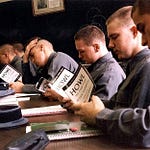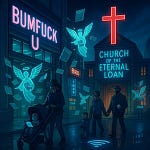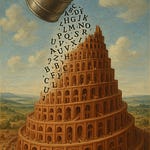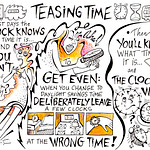"How is New York now, in 2025, as compared with New York then, in 1968?"
The question was asked by Anna Lurie Myers, a young woman who did not exist in 1968. She is coproducing a video with Oliver Katz (who also did not exist in 1968), on the ever-fascinating Andrei Codrescu, 78. It is a reasonable question on the face of it, because if New Yorkers have one common subject of conversation, it is about how the New York of yesteryear (cheap and fun) compares with the New York of now (expensive, tourist-infested). Poet John Godfrey summed it best in 2016: "It costs $30 if you open your door to go out." In 2025, it costs $45. That was the short answer, but to take it seriously can be vertiginous and interesting.
New York in 1968 presented itself to me in all its shabby glory, untended, dangerous, grumpy, stoned downtown, drunk uptown, divided by ethnicity and accents, cigarettes and whiskey, corrupt from City Hall to pool hall, hot-tempered, police brutal, explosively fashionable, unbearably exciting and defiantly itself. Great place to be a poet! My $60/month apartment on Avenue C & 6th Street was haute bohemia compared to the crash pads at Avenue C & 11th Street. And those were luxury quarters compared to the wire cages of the Bowery SROs.
Crabs (pubic lice) shared the room with Lobster-In-Green-Sauce at the El Quijote, the Chelsea Hotel restaurant. I had both when I lunched with William Burroughs there. The Chelsea was the glamorous dive where poets went to fuck and die.
I danced one perfect summer evening on Shirley Clark's Chelsea rooftop terrace with topless girls. When the full moon became full the girls disappeared. Someone explained, "They went to Leonard Cohen's room, Bob Dylan is there."
I instructed a platoon of my Puerto Rican neighbors to join a huge anti-war demonstration marching to the U.N. building, to chant "Oxydize the gargoyles!" The mounted police, already bored with chants of "LBJ LBJ how many kids did you kill today," charged us, batons swinging. They had never heard such a thing, we had to be perilous accent bandidos using that alien verse from Rimbaud to end the war. We ran. I took a fellow sprinter's hand and we took shelter under a lone tree in an empty lot on the Columbia campus, flanked by NYPD police on one side, throwing tear gas grenades, and Columbia students in the other, throwing them back. Lust pulsed through the fog of war. We attempted a kiss cut short by tears. We ran again, all the way downtown to NYU, where we met more cops and students enveloped in teargas. I knew a place where we might complete our kiss, at my fifth floor pad on Avenue C. We arrived there breathing hard, and found the door wide open and my rooms filled with students bandaging their wounds. There was no place to kiss so we pitched in to help. To this day that unfinished kiss haunts me.
Valerie Solanas shot Andy Warhol. That was 1968. Everybody was famous. I can drop names like five dollar bills floating down on a snowy night at 3 a.m. from a 16th story window on Broadway while skipping home from Max's Kansas City.
But that is not the point of this paragraph. I was Anna's age.
Every year since 1968 I returned to New York and each time found another city. The New Yorks of each return did not disturb in the least the city of 1968. I can recall and accurately design the city of each year. My memories of New York are sufficient to recreate the city visually and anecdotally, to a terrifying degree of clarity. In time, my gigs took me from downtown to midtown and then uptown, a growing circle far from 1968 when I thought that you had to get dressed or be teargassed if you went past 14th Street.
Marcel Proust, take off your hat now!
In 1991, for instance, from the fifth floor of the Chelsea Hotel above the marquee, Laura and I watched the falling snow. It was the night before Christmas. Through the fat snowflakes we made out a lit window in the building across the street. A party was going on. Slow-moving elders handed their coats to attendants, and then they headed straight to the bar, gesticulating all the way, a pantomime of heated argument.
Laura said, "I think they are theosophists." I disagreed. "They are communists."
We made a bet. If they were theosophists I would pay for the Lobster-in-Green-Sauce at the El Quijote. If they were communists, she would. I threw on my leather jacket and went across the street. The apartment door opened in a buzzing room. I bought two T-shirts from a merch table: one featured the famous photograph of young Che Guevara with beret and cigar, and the other displayed the bearded Karl Marx. In small print under the sexy communist and his bearded daddy was the constructivist lettering: "YOUNG COMMUNISTS OF AMERICA." The guys manning the "cash only" table informed me with a wink that they themselves were Troskyists, but what was the point of upsetting the old communists they were giving the party for, who were all over 80. It was also a Christmas party, but that was not discussed either, because in addition to other discomforts ("Stalin, for one") the elders were all atheists and Jewish to boot. I sat down at a table where the whiskey-drinking ancients engaged in a shouting match about the Spanish Civil War. Not one of them looked over 60. I deduced from this that New York commies never age from lack of outrage.
Over the New York of 1991, there superimposed themselves speedier New Yorks every year, each one with its own stories for me. The city itself mushroomed upward in height and abundance.
In 2025 in my little-changed Avenue C apartment now lived five NYU students who shared the $5,000 monthly rent.
The New Yorks in my memory don't mix with one another. Each one is integral, sitting atop the earlier one like a suitcase in a rising tower. The tower got one story higher every year, each one featuring "only in New York" stories. I had no trouble moving from one New York to another, better if a building still stood there, like the Chelsea Hotel, and a bit more difficult if I had to go around some new glass nightmare squatting on my demolished past.
When I die I am going to a dimension where a memory can instantly become the thing remembered. I will construct there all the New Yorks I knew and loved from 1968 until I died. In this place I can recreate all the people I knew and liked. Anybody who complains about how New York now is nothing like New York then, can come to my dimension and live there or just visit the New York they liked best. Or even better they can build out of their memories their own New Yorks.
New York is not the only city I will build in my postmortem infinity. I will also build Sibius, Romes, Napolis, Detroits, San Franciscos, Venices, Baltimores, Monte Rios, Baton Rouges, New Orleanses, and Yellvilles. I will remake in detail every city (or hamlet) I ever lived in.
There is only one proviso: in my mind-cities there will be no fascists. I will simply not make them.













